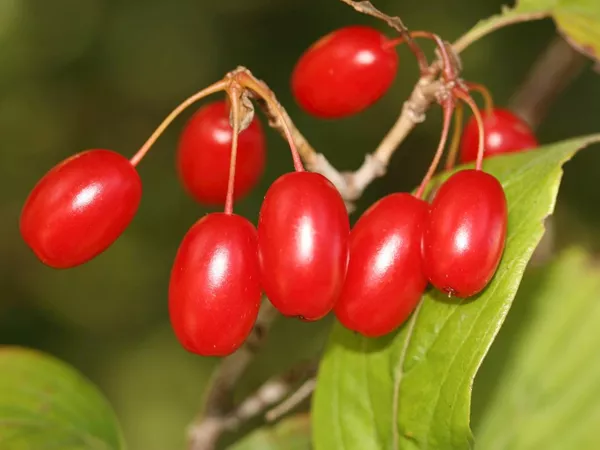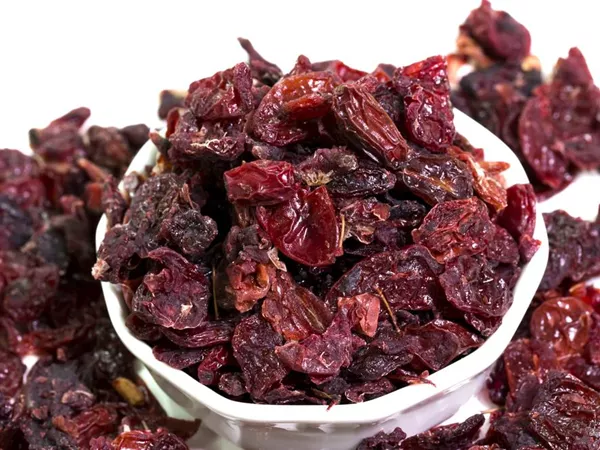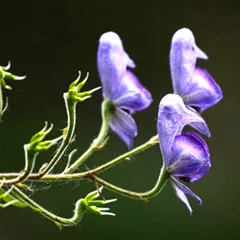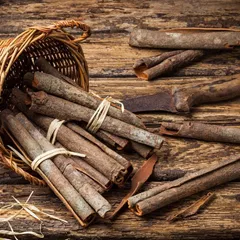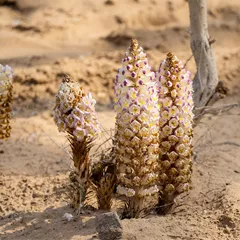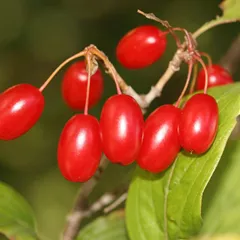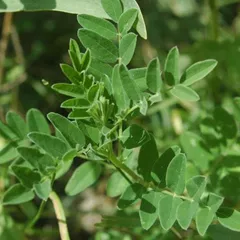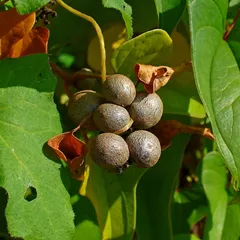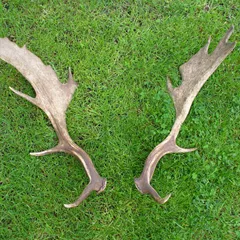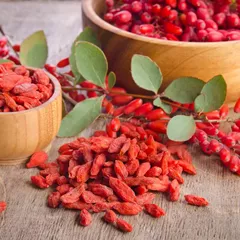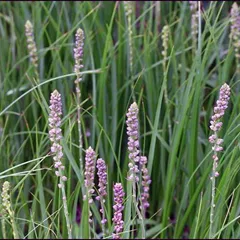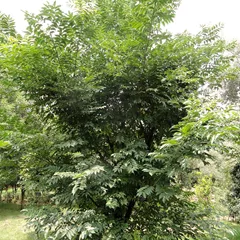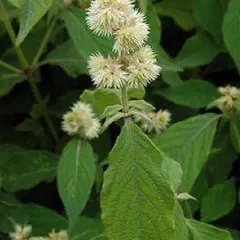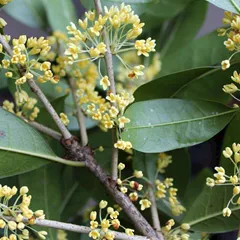Shan Zhu Yu
Shan Zhu Yu
English: Cornelian cherries
Chinese: 山茱萸
Parts used: Dried ripe sarcocarp
TCM category: Herbs that stabilize and bind
TCM nature: Warm
TCM taste(s): Sour
Scientific name: Cornus officinalis
Other names: Japanese cornel, Dogwood
Use of Shan Zhu Yu (cornelian cherries) in TCM
Please note that you should never self-prescribe TCM ingredients. A TCM ingredient is almost never eaten on its own but as part of a formula containing several ingredients that act together. Please consult a professional TCM practitioner, they will be best able to guide you.
Preparation: Harvest the fruit when it is red, cook it in boiling water on a slow fire, extract the sarcocarp and dry it.
Dosage: 3 - 12 grams
Main actions according to TCM*: Preserves and tonifies the Kidney, Liver and Essence. Stops sweating and benefits the Yang and Qi. Assists menstruation and stops bleeding.
Primary conditions or symptoms for which Shan Zhu Yu may be prescribed by TCM doctors*: Tinnitus Impotence Spermatorrhea Enuresis Metrorrhagia Leukorrhea Urinary incontinence Night sweats
Contraindications*: This herb should not be used by those with Fire symptoms or those with Damp-Heat and difficult or painful urination.
Common TCM formulas in which Shan Zhu Yu is used*
Zan Yu Dan
Source date: 1624 AD
Number of ingredients: 14 herbs
Formula key actions: Warms and tonifies the Kidneys.
Conditions targeted*: Erectile dysfunctionInfertility in male and others
Shan Zhu Yu is a king ingredient in Zan Yu Dan. Like the name indicates, it means it has more power than other ingredients in the formula.
In Zan Yu Dan, Shan Zhu Yu tonify the Kidneys and strengthen the Kidney Yang.
Gu Chong Tang
Source date: 1918-1934
Number of ingredients: 10 herbs
Formula key actions: Augments Qi . Strengthens the Spleen. Stabilizes the Penetrating Vessel. Stops bleeding.
Conditions targeted*: Dysfunctional uterine bleedingPostpartum bleeding and others
Shan Zhu Yu is a king ingredient in Gu Chong Tang. Like the name indicates, it means it has more power than other ingredients in the formula.
In Gu Chong Tang, Shan Zhu Yu tonifies the Kidneys and benefits the Liver but also has a binding action on the Penetrating and Directing vessels.
Experts claims that this herb strongly holds the Original Qi, lifts the Mind and stop Body Fluids leaking.
Ming Mu Di Huang Wan
Source date: 1642 AD
Number of ingredients: 12 herbs
Formula key actions: Nourishes the Liver. Enriches the Kidneys. Improves the vision.
Shan Zhu Yu is a king ingredient in Ming Mu Di Huang Wan. Like the name indicates, it means it has more power than other ingredients in the formula.
In Ming Mu Di Huang Wan, Shan Zhu Yu nourishes the Liver and restrains the leakage of Essence. It performs the latter function by inhibiting the improper dispersion and drainage through the Liver, thereby enabling the Essence to build up in the Kidneys. For this to occur, a substance with the strong, Essence building properties of the key herb (Prepared rehmannia) is also required.
Liu Wei Di Huang Wan
Source date: 1119 AD
Number of ingredients: 6 herbs
Formula key actions: Enriches the yin and nourishes the Kidneys.
Conditions targeted*: Chronic nephritisProstate diseases and others
Shan Zhu Yu is a deputy ingredient in Liu Wei Di Huang Wan. This means it helps the king ingredient(s) treat the main pattern or it serves to treat a coexisting pattern.
In Liu Wei Di Huang Wan, Shan Zhu Yu nourishes the Liver and restrains the leakage of Essence. It performs the latter function by inhibiting the improper dispersion and drainage through the Liver, thereby enabling the Essence to build up in the Kidneys. For this to occur, a substance with the strong, Essence building properties of the key herb (Prepared rehmannia) is also required.
Ba Wei Di Huang Wan
Source date: 220 AD
Number of ingredients: 8 herbs
Formula key actions: Tonifies Yang. Warms the Kidneys and lower extremities.
Conditions targeted*: Diabetes mellitusDiabetes insipidus and others
Shan Zhu Yu is a deputy ingredient in Ba Wei Di Huang Wan. This means it helps the king ingredient(s) treat the main pattern or it serves to treat a coexisting pattern.
In Ba Wei Di Huang Wan, Shan Zhu Yu nourishes the Liver and restrains the leakage of Essence. It performs the latter function by inhibiting the improper dispersion and drainage through the Liver, thereby enabling the Essence to build up in the Kidneys. For this to occur, a substance with the strong, Essence building properties of the key herb (Prepared rehmannia) is also required.
You Gui Wan
Source date: 1624 AD
Number of ingredients: 10 herbs
Formula key actions: Warms and tonifies Kidney Yang. Replenishes the Essence. Tonifies the Blood.
Conditions targeted*: Nephrotic syndromeOsteoporosis and others
Shan Zhu Yu is a deputy ingredient in You Gui Wan. This means it helps the king ingredient(s) treat the main pattern or it serves to treat a coexisting pattern.
Qi Ju Di Huang Wan
Source date: 1350 AD
Number of ingredients: 8 herbs
Formula key actions: Nourishes Kidney and Liver Yin. Improves vision.
Conditions targeted*: Diabetes mellitusDiabetes insipidus and others
Shan Zhu Yu is a deputy ingredient in Qi Ju Di Huang Wan. This means it helps the king ingredient(s) treat the main pattern or it serves to treat a coexisting pattern.
In Qi Ju Di Huang Wan, Shan Zhu Yu nourishes the Liver and restrains the leakage of Essence. It performs the latter function by inhibiting the improper dispersion and drainage through the Liver, thereby enabling the Essence to build up in the Kidneys. For this to occur, a substance with the strong, Essence building properties of the key herb (Prepared rehmannia) is also required.
Zuo Gui Wan
Source date: 1624 AD
Number of ingredients: 8 herbs
Formula key actions: Nourishes the Yin. Strengthens the Kidneys. Fills the Essence. Augments the marrow.
Conditions targeted*: Chronic bronchitisChronic nephritis and others
Shan Zhu Yu is a deputy ingredient in Zuo Gui Wan. This means it helps the king ingredient(s) treat the main pattern or it serves to treat a coexisting pattern.
In Zuo Gui Wan, Shan Zhu Yu nourishes the Liver Blood and restrains the leakage of Essence. It performs the latter function by inhibiting the improper dispersion and drainage through the Liver, thereby enabling the Essence to build up in the Kidneys. It works synergistically with Shu Di huang and Goji berries (Gou Qi Zi).
Zuo Gui Yin
Source date: 1624 AD
Number of ingredients: 6 herbs
Formula key actions: Nourishes the Yin. Tonifies the Kidneys.
Shan Zhu Yu is a deputy ingredient in Zuo Gui Yin. This means it helps the king ingredient(s) treat the main pattern or it serves to treat a coexisting pattern.
In Zuo Gui Yin, Shan Zhu Yu nourishes the Liver Blood and restrains the leakage of Essence. It performs the latter function by inhibiting the improper dispersion and drainage through the Liver, thereby enabling the Essence to build up in the Kidneys. It work synergistically with Shu Di huang and Goji berries.
Zhi Bo Di Huang Wan
Shan Zhu Yu is a deputy ingredient in Zhi Bo Di Huang Wan. This means it helps the king ingredient(s) treat the main pattern or it serves to treat a coexisting pattern.
In Zhi Bo Di Huang Wan, Shan Zhu Yu nourishes the Liver and restrains the leakage of Essence. It performs the latter function by inhibiting the improper dispersion and drainage through the Liver, thereby enabling the Essence to build up in the Kidneys. For this to occur, a substance with the strong, Essence building properties of the key herb (Shu Di Huang) is also required.
Ba Xian Chang Shou Wan
Source date: 1615 AD
Number of ingredients: 8 herbs
Formula key actions: Treats Yin Deficiency of the Lungs and Kidneys.
Shan Zhu Yu is a deputy ingredient in Ba Xian Chang Shou Wan. This means it helps the king ingredient(s) treat the main pattern or it serves to treat a coexisting pattern.
In Ba Xian Chang Shou Wan, Shan Zhu Yu nourishes the Liver and restrains the leakage of Essence. It performs the latter function by inhibiting the improper dispersion and drainage through the Liver, thereby enabling the Essence to build up in the Kidneys. For this to occur, a substance with the strong, Essence building properties of the key herb (Prepared rehmannia) is also required.
Ji Sheng Shen Qi Wan
Source date: 1695 AD
Number of ingredients: 10 herbs
Formula key actions: Tonifies and warms Kidney Yang.
Conditions targeted*: EdemaHeavy back and others
Shan Zhu Yu is a deputy ingredient in Ji Sheng Shen Qi Wan. This means it helps the king ingredient(s) treat the main pattern or it serves to treat a coexisting pattern.
In Ji Sheng Shen Qi Wan, Shan Zhu Yu is sour and slightly sweet. It tonifies the Liver and Kidneys, thereby helping to preserve the essential Qi while nourishing the Yin and reinforcing the Blood.
Strengthening the Kidney Qi is beneficial to its role as repository of the body's Yin and Yang. It also ensures that nourishment will be supplied to the Liver, which derives its Essence from the Kidneys.
The supply of Yin and Essence to the Liver serves to facilitate the free and smooth operation of its spreading function. It also restrains the leakage of Essence. It performs this function by inhibiting the improper dispersion and drainage through the Liver, thereby enabling the Essence to build up in the Kidneys.
Tiao Gan Tang
Source date: 1827 AD
Number of ingredients: 7 herbs
Formula key actions: Nourishes Kidney and Liver Yin.
Gui Shao Di Huang Tang
Source date: 1706 AD
Number of ingredients: 8 herbs
Formula key actions: Nourishes Blood. Nourishes Yin.
In Gui Shao Di Huang Tang, Shan Zhu Yu nourishes Liver and Kidney Yin
Da Bu Yuan Jian
Source date: 1624 AD
Number of ingredients: 8 herbs
Formula key actions: Tonifies Yin and Blood. Nourishes Qi and Yang.
Conditions targeted*: Uterine prolapse and others
In Da Bu Yuan Jian, Shan Zhu Yu nourishes Yin, Blood and Essence and strengthen Liver and Kidneys. Here it works synergistically with the chief herb Prepared rehmannia.
Shen Qi Wan
Source date: 220 AD
Number of ingredients: 8 herbs
Formula key actions: Tonifies and warms Kidney Yang.
Conditions targeted*: Diabetes mellitusHyperaldosteronism and others
In Shen Qi Wan, Shan Zhu Yu tonifies the Liver and Kidneys, thereby helping to preserve the essential Qi while nourishing the Yin and reinforcing the Blood. Strengthening the Kidney Qi is beneficial to its role as repository of the body's Yin and Yang. It also ensures that nourishment will be supplied to the Liver, which derives its Essence from the Kidneys. The supply of Yin and Essence to the Liver serves to facilitate the free and smooth operation of its spreading function. It also restrains the leakage of Essence. It performs this function by inhibiting the improper dispersion and drainage through the Liver, thereby enabling the Essence to build up in the Kidneys.
Dang Gui Di Huang Yin
Source date: 1640 AD
Number of ingredients: 7 herbs
Formula key actions: Nourishes Blood. Tonifies Kidney and Liver Yin. Regulates the menstrual cycle.
In Dang Gui Di Huang Yin, Shan Zhu Yu nourishes the Liver and restrains the leakage of Essence. It performs the latter function by inhibiting the improper dispersion and drainage through the Liver, thereby enabling the Essence to build up in the Kidneys. For this to occur, a substance with the strong, Essence building properties of the key herb (Shu Di Huang) is also required.
Key TCM concepts behind Shan Zhu Yu's properties
In Traditional Chinese Medicine (TCM), Shan Zhu Yu belongs to the 'Herbs that stabilize and bind' category. This category of herbs is used for treating abnormal discharges and displacement of Organs. This includes conditions such as diarrhea, discharges from the vagina, penis or rectum as well as prolapse of the Uterus or rectum. It is important to note that herbs in this category only treat symptoms, so one should also use herbs to treat the underlying Deficiency.
Furthermore Shan Zhu Yu is Warm in nature. This means that Shan Zhu Yu tends to help people who have too much 'Cold' in their body, although with less effect than a plant that would be Hot in nature. Balance between Yin and Yang is a key health concept in TCM. Those who have too much Cold in their body are said to either have a Yin Excess (because Yin is Cold in nature) or a Yang Deficiency (Yang is Hot in Nature). Depending on your condition Shan Zhu Yu can help restore a harmonious balance between Yin and Yang.
Shan Zhu Yu also tastes Sour. The so-called 'Five Phases' theory in Chinese Medicine states that the taste of TCM ingredients is a key determinant of their action in the body. Sour ingredients like Shan Zhu Yu helps with digestion and restrain abnormal discharges of Fluids from the body, such as diarrhea or heavy sweating.
The tastes of ingredients in TCM also determine what Organs and Meridians they target. As such Shan Zhu Yu is thought to target the Kidney and the Liver. According to TCM, the Kidneys do not only regulate the urinary system but also play a key role in the reproductive system and the growth and aging process of the body. The Liver on the other hand is often referred as the body's "general" because it is in charge of regulating the movements of Qi and the Body Fluids. It also takes a leading role in balancing our emotions.
Research on Shan Zhu Yu
C. officinalis contains ursolic acid which has shown in vitro protective effects on auditory cells.1
Ethanolic extracts of the fruit of C. officinalis has been shown to prevent hepatic injuries associated with acetaminophen-induced liver injury-induced hepatotoxicity (in mice) by preventing or alleviating oxidative stress.2
Cornel iridoid glycoside, a chemical extracted from Cornus officinalis, promoted neurogenesis and angiogenesis and improved neurological function after ischemia in rats.3
A randomized, double-blinded, placebo-controlled study found that a Chinese herbal formula that mainly consisted of Cornus officinalis was not only effective at improving erectile function, but it was also safe for the treatment of erectile dysfunction.4
A red ginseng extract-containing Torilus fructus and Corni fructus mixture improves facial wrinkles, a clinical sign of photoaging, and this improvement is associated with biochemical and histological Research Findings of increased collagen synthesis in the dermis.5
Sources:
1. Yu H.-H., Hur J.-M., Seo S.-J., Moon H.-D., Kim H.-J., Park R.-K., You Y.-O., "Protective effect of ursolic acid from Cornus officinalis on the hydrogen peroxide-induced damage of HEI-OC1 auditory cells". American Journal of Chinese Medicine 37 (4) (pp 735-746), 2009
2. Ha H., Lee N.-H., Seo C.-S., Lee H.-Y., Jung D.-Y., Lee J.-K., Lee J.-A., Song K.Y., Shin H.-K., Lee M.-Y., Seo Y.B., Kim H.,"Hepatoprotective and antioxidative activities of cornus officinalis against acetaminophen-induced hepatotoxicity in mice". Evidence-based Complementary and Alternative Medicine. 2012 , Article Number: 804924.
3. Yao RQ, Zhang L, Wang W, Li L "Cornel iridoid glycoside promotes neurogenesis and angiogenesis and improves neurological function after focal cerebral ischemia in rats." Brain Res Bull. 2009 Apr 6;79(1):69-76
4. Kam S.C., Choi S.M., Jeh S.U., Lee S.H., Hwa J.S., Jung K.H., Kang C.W., Hyun J.S.,"Efficacy and safety of a herbal formula that mainly consists of Cornus officinalis for erectile dysfunction: A double-blind, placebo-controlled study". Korean Journal of Urology. 48 (7) (pp 741-747), 2007.
5. Cho S, Won CH, Lee DH, Lee MJ, Lee S, So SH, Lee SK, Koo BS, Kim NM, Chung JH. (2009). Red ginseng root extract mixed with Torilus fructus and Corni fructus improves facial wrinkles and increases type I procollagen synthesis in human skin: a randomized, double-blind, placebo-controlled study. J Med Food. , 12(6):1252-9. doi: 10.1089/jmf.2008.1390.

